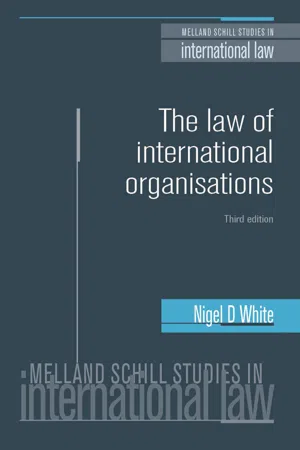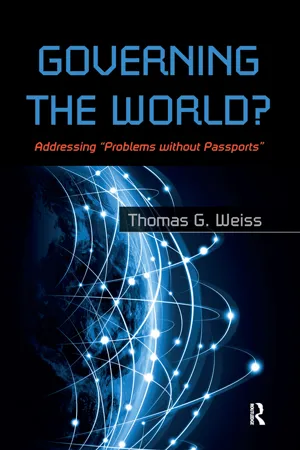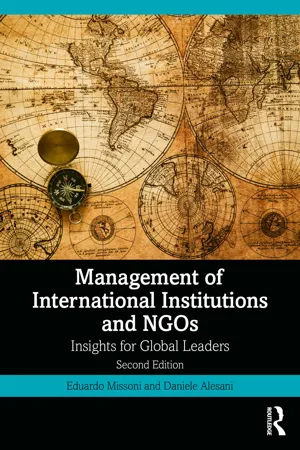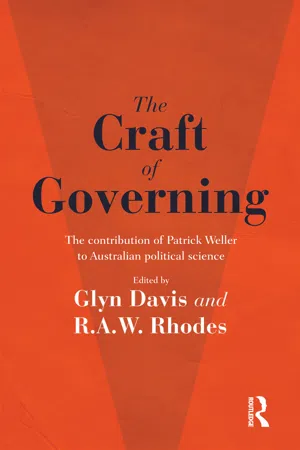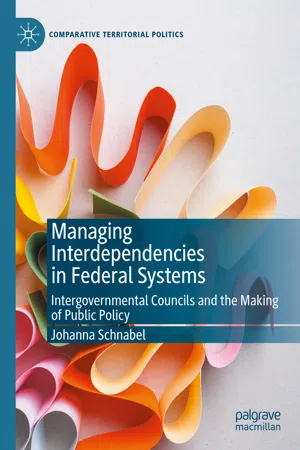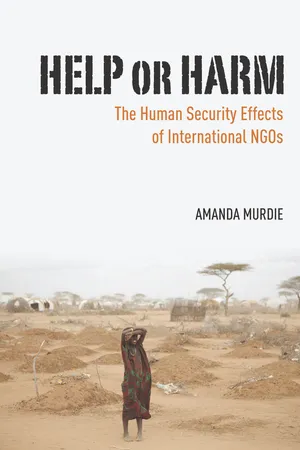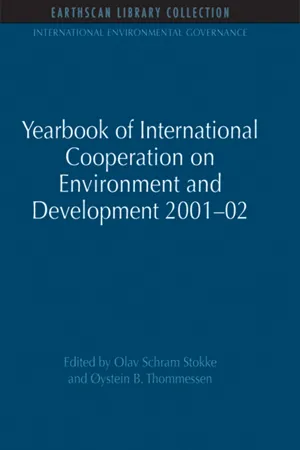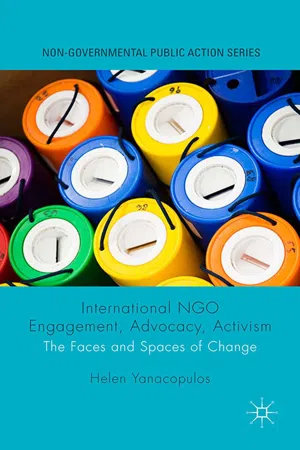Politics & International Relations
Intergovernmental Organisations
Intergovernmental organizations (IGOs) are entities formed by the cooperation of multiple national governments to address common issues and achieve shared goals. They provide a platform for member states to engage in diplomatic negotiations, coordinate policies, and collaborate on matters such as peacekeeping, trade, and environmental protection. Examples of IGOs include the United Nations, European Union, and World Trade Organization.
Written by Perlego with AI-assistance
Related key terms
10 Key excerpts on "Intergovernmental Organisations"
- eBook - ePub
- Hans Mouritzen(Author)
- 2019(Publication Date)
- Routledge(Publisher)
8 The Role of International OrganizationsIGOs: The Control-Relax Mechanism Reapplied
There are other types of actors in international politics than nation-states. Even though a state-centric conception of international politics is being presented in this book, it is important to single out the relationship between states and non-state actors, be it IGOs (international governmental organizations), INGOs (international non-governmental organizations), multinational corporations, or other types of entities. It is essential to identify a pre-theoretical mechanism characterizing the relationship between states and non-states. This mechanism is that of control-relax which was applied throughout chapters 6 and 7 regarding the role of internal factors in foreign policy. It is seen here as relevant in relation to all those types of non-state actors mentioned above; however, I shall apply it only to the relationship between states and IGOs and states and the EU1 .IGOs have been consciously designed by national governments in order to solve common problems that they cannot solve satisfactorily on their own - be it the regulation of war, trade, or transport or problems pertaining to development, the environment, human rights, etc. IGOs may be of a regional or universal scope (e.g. the Organization of African Unity' vs. the United Nations); that distinction is unimportant here. The sheer number of IGOs has grown exponentially during the 20th century, notably after World War II; that is why certain IR schools have ascribed them an increasing importance in international politics, perhaps even rivalling that of nation-states.As will be argued here, IGOs can be seen as the twining plants of international co-operation: firstly they are weak (cannot keep upright without support), secondly they are beautiful (supposed to serve beautiful purposes) and thirdly they are virtually impossible to get rid of. IGO weakness is most pronounced in high politics. But how can these weak creatures be so difficult to get rid of? Because the most powerful actors in international politics nation-states - wish IGOs to survive, even if they should appear redundant or inefficient in relation to their official purposes. The reason is that IGOs serve certain national vested interests (i.e. behind the facade), including beneficial unintended consequences flowing from their sheer existence. Just as beautiful twining plants can serve to hide ugly walls, for instance. On the one hand, nation-states do not allow IGOs to function too well and become too influential - especially not in high politics. On the other hand, they do not allow them to disappear. - eBook - ePub
The law of international organisations
Third edition
- Nigel D. White(Author)
- 2016(Publication Date)
- Manchester University Press(Publisher)
It will be seen throughout this book that the law of international organisations has been shaped over time by the various approaches and theories outlined above, reflecting the ideological positions of states and other actors over time. Some theories such as realism seek to limit the autonomy and powers of IGOs, others such as liberalism see IGOs as a progressive development enabling states and individuals to achieve a better life through cooperation. The more critical and radical approaches view IGOs as reinforcing inequities and inequalities, although they recognise that they can be vehicles through which alternative visions and opinions can be channelled. It follows that IGOs are at the fulcrum of debates about the nature of international relations, international society and community, and of course, international law. It follows that the law of international organisations, as a specialist area of international law applicable to IGOs, is also part of the debate. This presents a challenge to the caricature of law; one that sees law as somehow above politics and debate, and furthermore something stable and even immutable. Law reflects political debate and so the law of international organisations is a mixture of a relatively limited number of clear principles and norms, where consensus has been achieved and maintained, and of contested and differing understandings and interpretation where it has not. Once established, international law, especially fundamental principles, can also regulate and control politics and the exercise of political discretion.Law plays a foundational role in international organisations in that whatever view is taken of the character of an IGO, the constitutive treaty provides the legal framework within which the IGO should operate. If the organisation steps outside this framework, its actions can be analysed in terms of it acting illegally or ultra vires - William E. DeMars, Dennis Dijkzeul(Authors)
- 2015(Publication Date)
- Routledge(Publisher)
4 The co-evolution of non-governmental and intergovernmental organizations in historical perspective Bob Reinalda DOI: 10.4324/9781315728155-4This chapter traces the emergence of non-governmental organizations and intergovernmental organizations (NGOs and IGOs) as part of wider changes in the international system of states. It does not take the traditional Westphalian state as its point of departure but looks upon the territorial state as a historical process, in which non-governmental actors have achieved their place as well. While most International Relations (IR) theory builds on sovereignty and warfare as the main characteristics of modern state building since 1648, this chapter includes the declaration of new ideas about “popular sovereignty” and “human rights” during the War of American Independence (1776) and the French Revolution (1789), as well as the transformation of these ideas into political reality through political struggle by citizens both nationally and internationally. It discusses the emergence of multilateralism at the Congress of Vienna (1814–15), which set in motion a number of innovations, inventions and learning processes, as a new phase of the Westphalian state. It also discusses the rise of private organizations with a public purpose, which were well aware of this new multilateralism and developed transnational networks in order to have a stronger power base within it. The growth of multilateral and follow-up conferences, which proved to be open to NGO influence, resulted in a process of institutionalization, with IGOs based on regular general assemblies, permanent secretariats, a professionalization of its staff and an open stance towards NGOs. The next phase of international organization was characterized by an increase in scale of international bureaucracies, including forms of control over NGOs. This chapter argues that during the last two centuries NGOs and IGOs have co-evolved by constituting networks in which they engaged in a two-way instrumentalization.1- eBook - ePub
Governing the World?
Addressing "Problems Without Passports"
- Thomas G Weiss(Author)
- 2015(Publication Date)
- Routledge(Publisher)
HAPTER FOUR INTERGOVERNMENTAL ORGANIZATIONS THAT WORKDespite the need for them that is so apparent in these pages, current intergovernmental organizations are flimsy; they are without human and financial resources commensurate with the size of the transborder problems that they are supposed to address. Even such powerful ones as the UN Security Council and the World Bank often lack funds or authority or both. Other organizations are under construction or are not up to current building codes (so to speak); still others have architectural plans on drawing boards with only a prototype, not the real thing, to address gargantuan demands. As indicated earlier, it is not so much the numbers of IGOs that is the concern but rather feeble mandates, inadequate resources, and no autonomy. We require better, not more, IGOs.Global governance is uneven, giving the impression of coverage but often with too little practical effect. Appearances can be not only deceiving but also deadly; a well-populated institutional terrain can mask a lack of coherence, substance, and accomplishment. We may feel virtuous and persuade ourselves that we are making progress when actually we are treading water, wasting time and energy rather than moving swiftly toward safety; we may even be drowning what we are trying to rescue.The past quarter century has witnessed a sea-change in knowledge, norms, and policies to address some of the planet’s ills. We are not starting from scratch. Yet steps in the right direction must find a home within effective institutional structures if responses are to avoid being ad hoc, episodic, idiosyncratic, and ultimately inadequate. Collective efforts backed with financial resources and qualified people have clout, whereas those without do not. - eBook - ePub
Management of International Institutions and NGOs
Insights for Global Leaders
- Eduardo Missoni, Daniele Alesani(Authors)
- 2023(Publication Date)
- Routledge(Publisher)
Blokker 2001 ; Zanghì 2007). This character distinguishes them from simpler and less formalized intergovernmental agreements.INGOs are constituted as foundations, associations, or co-operatives under national law and are neither subject to international law nor formally regulated by it (see Chapter 2 ). As a consequence, legal status, governance, and representation models of INGOs are very diverse. For example, regarding institutional forms, out of 249 INGOs headquartered in Switzerland 67% are constituted as associations, 16% as foundations, 1% as co-operatives, and 16% report having a different legal form or no regular legal status (Rehli 2011 ). This group encompasses large federations such as the International Olympic Committee, foundations such as the Kofi Annan Foundation, advocacy associations such as the World Wide Fund for nature, international relief organizations such as the International Committee of the Red Cross, but also many smaller organizations, active in very different fields.With regard to membership, INGOs federate national organizations that may be of different juridical nature depending both on organizational choices and the national laws of the countries where they are established (Martens 2003 ).2 These national organizations may be associations of individuals or capital-based foundations established through an endowment fund and therefore without individual membership (see Chapter 2 ).The internal governance structure of IIs and INGOs, conceived as a system of organizational mechanisms, is determined by four general criteria (Zanghì 2007 ):- Functional criterion;
- Plurality of bodies;
- Collective bodies;
- Bodies composition.
According to the functional criterion, goals, mission, vision, and functions of the organization shape its governance. These drivers determine the institutional form, the number and composition of governing, and operational organs and the powers attributed to them. - eBook - ePub
The Craft of Governing
The contribution of Patrick Weller to Australian political science
- R.A.W. Rhodes(Author)
- 2020(Publication Date)
- Routledge(Publisher)
The influence of economics on US political science is not news to any corner of the discipline, but international relations was (rather typically) a late adopter. Many of the areas of interest to Weller and Xu, such as free trade, guarding intellectual property, fighting pandemics, lender of last resort facilities and so on, came to be seen as examples of potential or actual market failure or collective action problems. International-relations scholars drew upon the writings of economists such as George Akerloff, Mancur Olson and Charles Kindleberger in both framing their understanding of such problems, and in considering solutions. The goals of non-security international organisations came to be seen as public goods, and the major obstacle to providing these goods was held to be states’ tendency to free-ride, failing to bear their share of the costs involved. The potential solution was argued to be mechanisms that monitor and exclude free-riding states from the benefits of future cooperation, thus overcoming the short-term incentive to free-ride by consuming but not contributing to public goods (Axelrod 1984; Keohane 1984; Oye 1986). International organisations could play just this role, whether it was the General Agreement on Tariffs and Trade or the World Intellectual Property Organization. In this rendering, though international organisations were definitely the instruments of states, they nevertheless played a vitally important role in fostering and maintaining cooperation that individual states could not manage in isolation.A further development of this rational-choice-inspired scholarship granted an important measure of autonomy to international organisations, based on the principal–agent framework first developed to explain the relationship between shareholders and company managers. Of course, principal–agent work based on the key concepts of goal diversity and information asymmetry is well known to scholars of public policy for modelling the relationship between voters and elected politicians, or even more so between elected politicians and bureaucrats. In the international relations version, states are the principals that create and fund international organisations, while the IOs themselves are the agents who enjoy de facto autonomy, thanks to their superior detailed knowledge of the task at hand and their own efforts to complete it (Nielson and Tierney 2003; Hawkins et al. 2006). IOs are vested with some significant political autonomy in pursuing their own goals, rather than being just unthinking tools of states. As detailed below, this picture is much closer to Weller and Xu’s version of IOs as genuine political entities worth studying in their own right, and not mere talk shops, or arenas for negotiation, or instruments of states. The cover of one of the major volumes of this principal–agent work references the metaphor noted earlier by having a stylised puppet cutting the strings held by the puppeteer. A particular focus of those working from a principal–agent perspective is the special challenges faced by a collective principal, i.e. rather than just one minister running a department, a group of perhaps dozens of states hold their ostensible servants accountable. - eBook - ePub
Managing Interdependencies in Federal Systems
Intergovernmental Councils and the Making of Public Policy
- Johanna Schnabel(Author)
- 2020(Publication Date)
- Palgrave Macmillan(Publisher)
federal constitution or the passage of legislation mandating their creation.Intergovernmental councils are more or less regular meetings of the different governments of a federation. At these meetings, governments establish policy solutions to problems they are all confronted with (Behnke & Mueller, 2017 ; Cameron, 2001 ; Watts, 2003 ). Intergovernmental councils comprise high-level politicians such as prime ministers or cabinet ministers that “share information, discuss common problems, contemplate co-ordinated or even joint action and where appropriate establish joint bodies or agencies” (Watts, 2003 , p. 4). Meetings of (senior) officials can also be part of an intergovernmental council in which case they serve the purpose of preparing or implementing decisions of a council’s plenary assembly, which consists of politicians.2 Different types of intergovernmental councils exist (Bolleyer, 2009 , pp. 17, 69–70; see also Cameron, 2001 ). Based on membership, one can distinguish between vertical councils comprising the federal government and the constituent units, and horizontal councils in which the federal government does not participate, as well as between national, multilateral, regional, and bilateral councils depending on the number of constituent units participating.3 Furthermore, while policy-specific councils focus on a specific area and consist of ministers, generalist - eBook - ePub
Help or Harm
The Human Security Effects of International NGOs
- Amanda Murdie(Author)
- 2014(Publication Date)
- Stanford University Press(Publisher)
Yearbook still excludes organizations that are strictly bilateral. Many bilateral organizations could be said to not be “international” in scope, also limiting them from this book’s definition of an INGO.Although the UN system refers to international NGOs as just “NGOs,” the academic literature has made a distinction between organizations that are completely domestic and organizations that are international (Boli and Thomas 1999; Ahmed and Potter 2006). I follow that distinction here. Organizations only involved within a particular country and only interested in working with their mission within that country can still be very important for international politics; as discussed below, these domestic NGOs are theoretically crucial players in the transnational advocacy networks where INGOs often work (Keck and Sikkink 1998; Risse, Ropp, and Sikkink 1999). However, domestic NGOs, often referred to as “nonprofits” in the American politics literature, are, in many ways, separate from our discussion and focus here on INGOs. These organizations may not be routinely working within both international and domestic arenas; they are more likely to just be working with domestic actors, both state and nonstate. Much of their decision calculus would be different from INGOs or, at the very least, may be on a very limited scale. For example, instead of trying to decide which countries to work in for a year, the organization may be deciding which neighborhoods to be working in for a year. Organizational members may not have aspirations of ever leaving the state. Instead of taking successful strategies from Argentina, for example, and using them in Peru, the organization may be taking strategies from, say, one area of Bolivia and using them in another area of Bolivia (Keck and Sikkink 1998; Boulding 2010). This is not to say that there are many similarities between domestic and international NGOs; in fact, many INGOs, like the March of Dimes, started out as specifically domestic NGOs and then expanded both their mission and their activities. Instead, for this book, I simply acknowledge that there are differences between international and domestic NGOs, both on-the-ground differences and differences in the academic literature, and restrict my focus to only organizations that can be classified as international. I do acknowledge, however, that many of the same dynamics I present in this chapter and then use to motivate my theoretical argument in Chapter 3 - Olav Schram Stokke, Oystein B. Thommessen(Authors)
- 2013(Publication Date)
- Routledge(Publisher)
NTERGOVERNMENTAL ORGANIZATIONS (IGOs) including United Nations specialized agencies Commission on Sustainable Development (CSD) European Union (EU): Environment Food and Agriculture Organization (FAO) Global Environment Facility (GEF) International Atomic Energy Agency (IAEA) International Council for the Exploration of the Sea (ICES)* International Fund for Agricultural Development (IFAD) International Labour Organization (ILO) International Maritime Organization (IMO) International Monetary Fund (IMF) International Oil Pollution Compensation Funds (IOPC Funds) Organization for Economic Co-operation and Development (OECD), Environment Policy Committee (EPOC)* United Nations Children’s Fund (UNICEF) United Nations Development Programme (UNDP) United Nations Educational, Scientific, and Cultural Organization (UNESCO) United Nations Environment Programme (UNEP) United Nations Industrial Development Organization (UNIDO) United Nations Population Fund (UNFPA) World Bank World Food Programme (WFP) World Health Organization (WHO) World Meteorological Organization (WMO) World Trade Organization (WTO) * included in Tables of International Organizations and Degrees of Participation, by Country and TerritoryPassage contains an image
Commission on Sustainable Development (CSD)
- eBook - ePub
International NGO Engagement, Advocacy, Activism
The Faces and Spaces of Change
- Helen Yanacopulos(Author)
- 2015(Publication Date)
- Palgrave Macmillan(Publisher)
Almost by definition, INGOs that work in development are first and foremost trying to change a given situation. Whether they are providing basic services, setting up a school, or empowering women to become entrepreneurs, all are arguably inherently political acts. In addition, INGOs work across borders and at different scales, from the ‘local’ grassroots level, to those of global governance. This is captured by Lang (2013: 12) who claims that the INGO sector has been ‘credited with playing a central part in establishing new geographies of political power at the intersection of civil society and institutional politics’. In Ulrich Beck’s (2006) Cosmopolitan Vision, he argues that there are ‘other spaces’ produced as a result of such global changes. Both of these factors, taken in the context of the shifting landscapes enabled by the globalisation of information and communication technologies, from the Internet to the global media sphere, have produced the impression of space ‘shrinking’ and a rapid shifting of INGOs’ operating environments. Given these significant shifts, it is vital to look at the different political spaces that INGOs inhabit, and how they have utilised a range of different political terrains. Smith and Smythe (2009: 794) ask, ‘[W]hat will be the new vocabulary and spaces of politics?’ Attempting to suggest some answers to their question will provide the focus of the following five chapters. The idea of ‘opening up’ political spaces has become prevalent; it is an idea that has been used by political activists from the streets of the Arab Spring (Salih, 2014) to the contagious Occupy movement, 1 and to the various regional and World Social Forums (Sen, 2010). Terms such as ‘deliberative space’, ‘mediascapes’, ‘transnational spaces’ and ‘virtual – or digital – space’ are now widespread in the academic literature, as well as in the discourses of activists
Index pages curate the most relevant extracts from our library of academic textbooks. They’ve been created using an in-house natural language model (NLM), each adding context and meaning to key research topics.

